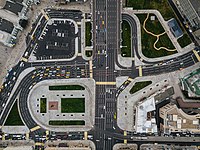
Photo from wikipedia
Abstract Flow patterns for water-butanol, water-toluene, water-hexane, water-oil and water/glycerol (weight ratio 60:40) mixture-oil two-phase flows were visualized in the cross-shaped junctions of three square glass microchannels with hydraulic diameters… Click to show full abstract
Abstract Flow patterns for water-butanol, water-toluene, water-hexane, water-oil and water/glycerol (weight ratio 60:40) mixture-oil two-phase flows were visualized in the cross-shaped junctions of three square glass microchannels with hydraulic diameters of 200 µm, 400 µm and 600 µm. The aqueous phase is the continuous phase contacting the channel walls while the organic phase is the dispersed phase in the experiments. Three main flow pattern groups were observed, including the tubing/threading regime group, the dripping regime and the jetting regime. The flow regimes were mapped based on the Capillary number of the continuous phase and the Weber number of the dispersed phase. The flow rate ratio and the Capillary number of the dispersed phase were also employed to present flow patterns. The effects of hydraulic diameter of the square microchannels, flow rates, and physical properties, e.g., the interfacial tension and the viscosities of the aqueous and organic phases on flow pattern transitions were clarified. Besides, in the dripping regime, the dimensionless slug length can be scaled as a function of the Capillary number of the continuous phase for cross-shaped junctions. The slug velocity is linearly dependent on the average flow velocity in the dripping regime.
Journal Title: Chemical Engineering Science
Year Published: 2017
Link to full text (if available)
Share on Social Media: Sign Up to like & get
recommendations!